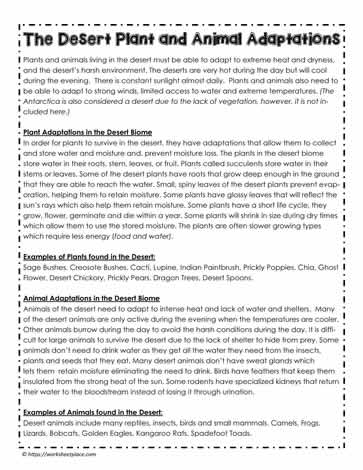| |||||
| Desert Plant and Animal Adaptations For Google Apps | |||||
| Plants and animals living in the Desert must be able to adapt to extreme heat and dryness, and the Desert’s harsh environment. The Deserts are very hot during the day but will cool during the evening. There is constant sunlight almost daily. Plants and animals also need to be able to adapt to strong winds, limited access to water and extreme temperatures. (The Antarctica is also considered a desert due to the lack of vegetation, however, it is not included here.) Plant Adaptations in the Desert Biome In order for plants to survive in the desert, they have adaptations that allow them to collect and store water and moisture and, prevent moisture loss. The plants in the Desert biome store water in their roots, stem, leaves, or fruit. Plants called succulents store water in their stems or leaves. Some of the desert plants have roots that grow deep enough in the ground that they are able to reach the water. Small, spiny leaves of the desert plants prevent evaporation, helping them to retain moisture. Some plants have glossy leaves that will reflect the sun's rays which also help them retain moisture. Some plants have a short life cycle, they grow, flower, germinate and die within a year. Some plants will shrink in size during dry times which allow them to use the stored moisture. The plants are often slower growing types which require less energy (food and water). Examples of Plants found in the Desert: Sage Bushes, Creosote Bushes, Cacti, Lupine, Indian Paintbrush, Prickly Poppies, Chia, Ghost Flower, Desert Chickory, Prickly Pears, Dragon Trees, Desert Spoons. Animal Adaptations in the Desert Biome Animals of the desert need to adapt to intense heat, and lack of water and shelters. Many of the Desert animals are only active during the evening when the temperatures are cooler. Other animals burrow during the day to avoid the harsh conditions during the day. It is difficult for large animals to survive the desert without shelter to hide from. Some animals don’t need to drink water as they get all the water they need from the insects, plants and seed that they eat. Many desert animals don't have sweat glands which enables them to retain moisture and not need to drink. Birds have feathers that keep them insulated from the strong heat of the sun. Some rodents have specialized kidneys that return their water to the bloodstream instead of losing it through urination. Examples of Animals found in the Desert: The animals of the desert tend to be reptiles, insects birds and small mammals. Camels, Frogs, Lizards, Bobcats, Golden Eagles, Kangaroo Rats, Spadefoot Toads. | |||||

All worksheets are created by experienced and qualified teachers. Send your suggestions or comments.